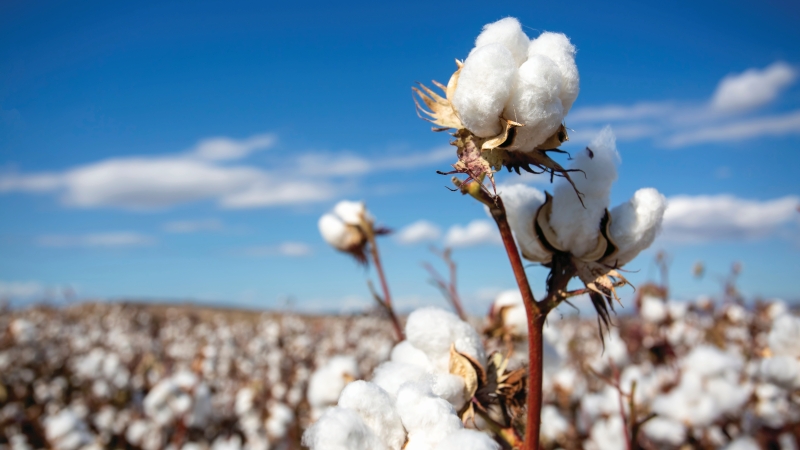Clemson Scientists Share New Research, Technology with SC Farmers

Modern research and technology are important for today’s farmers, and researchers at Clemson’s Edisto Research and Education Center are busy developing software and other scientific instruments to help South Carolina farmers produce profitable crops.
The researchers shared their latest knowledge during the Edisto REC’s 2018 Fall Field Day. A project supported by Cotton Inc., aimed improving placement of crop inputs to increase profitability was the focus of one of Kendall Kirk’s presentations. Kirk, a precision agriculture engineer, talked about how farmers can use Clemson’s Directed Rx variable rate technology system to maximize nitrogen use efficiency while maximizing cotton yields.
In contrast to conventional, uniform rate application, variable rate application involves making prescriptions to assign different rates to different areas of a field. Kirk has shown an increase in profits by as much as $15 per acre by using this technology to grow cotton crops. Equally important, Kirk says this profit benefit is accompanied by an environmental benefit. Nitrogen use efficiency (NUE) for this system was 2.7% higher than that for the most profitable uniform nitrogen rate and 44% higher than that for the highest yielding nitrogen rate. NUE is a measure of crop yield per unit nitrogen input – an increase in cotton NUE means that more cotton was produced with less nitrogen.
“This system uses yield and soils data from a field to optimize the prescribed inputs for a specific field,” Kirk said. “What is unique about this system is it does not use data from other sites. It just uses data from the field in question. So, growers can get personalized prescriptions for each field, input and crop.”
Kirk also talked about how proper operation of a peanut digger can cut costs and losses associated with peanut harvest. Kirk and technician Ben Fogle are looking at how speed affects peanut losses. The study has shown losses to more than double when the ground speed goes from 3 miles per hour to 4 miles per hour. Yields also decreased when speed increased. When setting digging speeds, growers should keep several variables in mind, particularly soil conditions. Slower speeds should be used where digging losses are more likely, such as with larger pods, suboptimal maturity, heavier soils and drier soils.
“We’ve found traveling 1.5 miles per hour to 3 miles per hour on a digger is the optimum speed to use when harvesting Virginia peanuts,” Fogle said. “The message for peanut growers is to slow down a little bit.”
Irrigation technologies
Information-based production (precision agriculture) technologies are becoming more popular with farmers. Irrigation is one input that can be scheduled using sensor-based methods to increase net returns and maximize irrigation water use efficiency. Michael Plumblee, Extension precision agriculture specialist, and Jose Payero, irrigation specialist, talked about how using soil moisture sensors can help farmers meet their crops’ irrigation requirements.
Determining soil moisture sensor thresholds is important, Plumblee said. His presentation centered around developing soil moisture sensor irrigation thresholds for cotton crops planted in loamy sand soil, which is common in the coastal plain.
“In order to meet the crop water-use demand, farmers must irrigate at the correct times,” Plumblee said. “Proper irrigation scheduling can help reduce plant stress and over-watering while helping maximize yield and profit.”
Plumblee also suggests using soil moisture sensors to achieve real-time, site-specific monitoring. The two categories of soil moisture sensors are volumetric water content sensors, which measure the amount of water in a given volume of soil, and soil water tension sensors, which measure the ability of roots to extract water from soil. The higher the tension, the dryer the soil. Depending on irrigation system size, type of pump and crop grown, Plumblee said farmers could see significant profit increases from utilizing a proper irrigation scheduling method.
There’s also free software farmers can use for irrigation scheduling. Two computer programs developed by Payero are the South Carolina Crop Water Requirement Calculator and the South Carolina Irrigation Scheduling Tool. Both programs use information input by users to determine irrigation needs.
Controlling crop diseases and pests
In discussions about diseases and pests, Dan Anco, Extension peanut specialist, advised growers to manage peanuts as a perennial crop, saying rotating out of peanuts for at least two years is “huge” in helping reduce pressure from late leaf spot.
To help take care of tomato spotted wilt virus and thrips, James Thomas, agriculture science associate, suggested planting resistant varieties, planting in mid-May, applying in-furrow treatments of Thimet and using strip-tillage to reduce surface crop residue and twin-row planting to create faster ground cover can help reduce plants’ risk of contracting the virus.
To control thrips in cotton, entomologist Jeremy Greene advised growers to use AgLogic 15G, which is aldicarb.
To control nematodes, John Mueller, Clemson University Extension row crop pathologist, said growers need to have a plan that includes sampling fields in the fall when nematode numbers are highest.
“If you believe you may have nematodes in your field, pull a few plants and look at the roots,” Mueller said. “Send samples to Clemson’s Nematode Assay Lab. If you had a good crop the previous year, don’t take it for granted and think that you won’t have any problems during the current year.”
Mueller also advised growers to have soil tested in Clemson’s Soil Testing Lab to eliminate any potential soil fertility issues.
In other cotton-related research, Joe Mari Maja, a research scientist, is testing mobile robot capability for field operation and cotton harvest. Bhupinder Farmaha, nutrient management specialist, is studying to determine how much nitrogen is required to maximize cotton yields.
Cotton, soybeans and peanuts are top commodities in South Carolina. Figures from the USDA-NASS for 2017 show 248,000 acres of cotton were harvested in South Carolina for a total value of almost $152 million. A total of 390,000 acres of soybeans were harvested in 2017 for a total value of about $138 million, and 118,000 acres of peanuts were harvested yielding 472 million pounds for a total value of almost $106 million.









